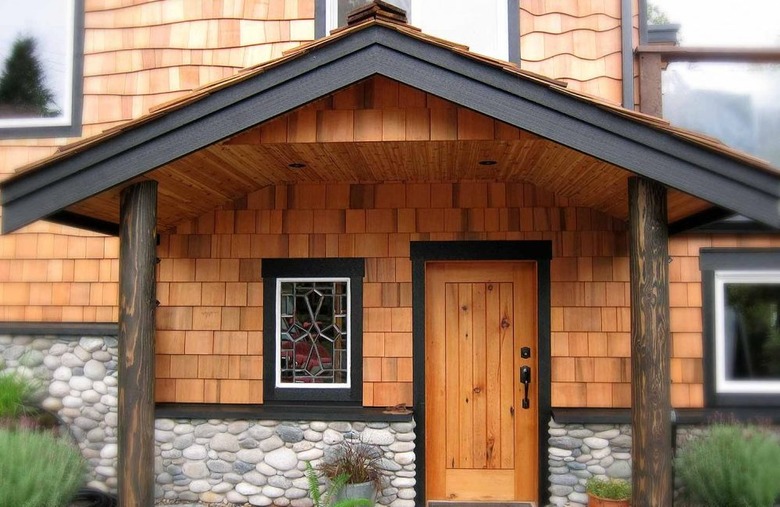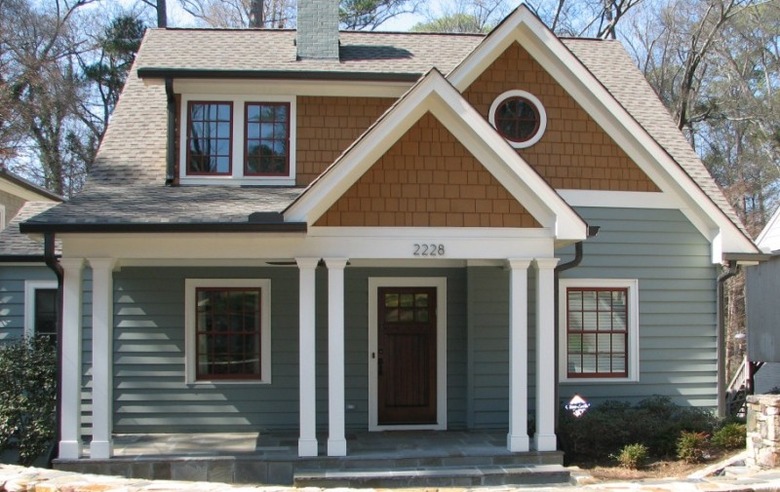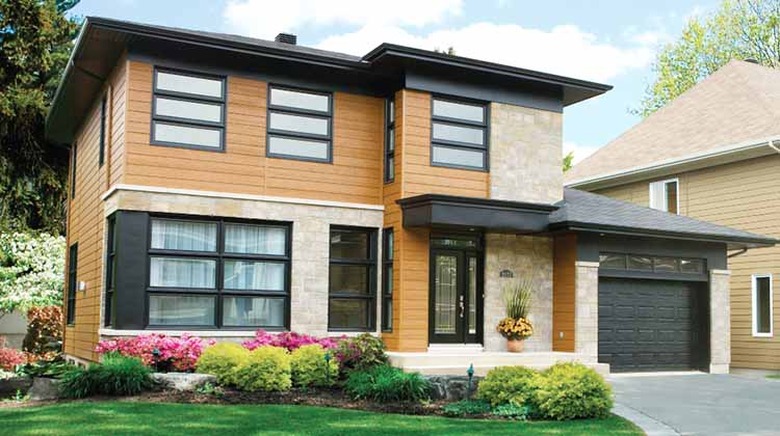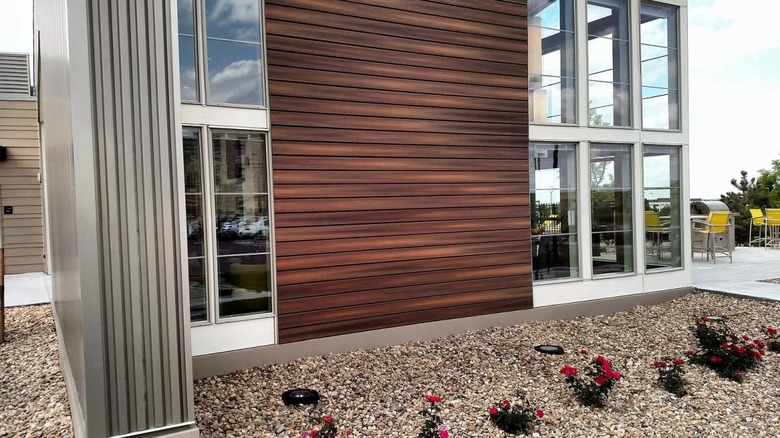An Introduction To Wood And Composite Siding
As the exterior cladding on a traditional-styled home, it's hard to beat the classic warmth of wood. That's what most people envision when they think of siding and that's what the majority of siding manufacturers aim to emulate, no matter what materials they are using. In addition to its natural beauty, wood is resilient and easy to cut and shape. The natural oil in cedar resists decay and insect infestation. Wood siding has a very long history of use and it's easy to see that, with proper care, it can last for generations. However, that issue of proper care is one of the downsides to real wood siding. It's recommended that painted wood siding be repainted every five years and that stained or clear-coated cedar be refinished more often than that.
Cedar is the wood of choice for siding but it tends to be expensive, especially when you factor in the projected cost of regular maintenance. Cedar siding comes in various grades, with the lower (and least expensive) grades exhibiting the most knots and blemishes. If you plan to paint the siding, those lower grades may be perfectly suitable, but if you intend to use clear sealer or semi-transparent stain, more blemish-free siding may be required. The best, most blemish-free cedar siding is harvested from old growth forests, making it far from a sustainable resource. To assure that the natural wood siding you use comes from sustainable sources, look for products certified by the Forest Stewardship Council.
Wood siding can take any of several forms:
Horizontal lap boards (also called clapboard) are long individual boards, tapered in the short direction and overlapped when applied. The boards may be anywhere between four and twelve inches wide with a corresponding overlap from one to two inches.
Shingles and shakes were traditionally wedge-shaped slices taken from a block of cedar. Shingles were sawn and shakes were split, giving shakes a more rustic, irregular appearance. Even now when both are sawn and the rough face on shakes is mechanically produced, shakes are usually thicker than shingles. Shakes are often installed with a staggered bottom edge to further promote the rustic effect. Shingles are typically installed with the bottom edge aligned. At extra expense, shingles with a shaped bottom edge may also be used to produce contrasting patterns in the siding.
Board-and-batten siding consists of flat boards (commonly twelve inches wide but not always), installed vertically with narrow boards (battens) attached over the joints. Gaps in the joints under the battens allow for seasonal expansion of the siding. Pine can also be used effectively for board and batten siding, as long as its carefully maintained.
Plywood siding, also made from fir or pine, is the most economical of the wood siding options. Sold in four by eight or four by ten foot sheets, the face of the panels is rough sawn and grooved to suggest boards. Also called T1-11 siding, plywood panels are by far the easiest to install.
Fiber Cement Siding
In part because the supply of quality wood siding is diminishing and the price continues to rise, manufacturers have developed and continue to develop wood look-alike products, each with its own benefits and liabilities. Fiber cement siding is pressure molded from Portland cement, wood fiber, clay and a filler such as sand or fly ash. In the mold, it's given a texture and form that mimics natural wood products. Intuitively you would expect a product made of cement to be extremely durable and weatherproof, and under the right conditions it is. However, cement alone would be quite brittle, so the wood fiber has been added to improve the siding's resilience. Even with that addition, fiber cement siding is more prone than any other type of siding to cracking if not handled properly. The need for correct handling is further complicated by the heaviness of the product. The stone-like hardness of fiber cement siding requires special blades to cut it, and the cutting produces harmful silica dust that demands the use of a respirator. The procedures for installing fiber cement siding and even for its storage prior to installation are exacting. Failure to comply with those procedures can result in failure of the product and can also void the manufacturer's warranty.
Unlike stone, cement in general and fiber cement, in particular, is porous and absorbent. The siding when installed is either primed and ready to paint, or it is factory-primed and painted on the exterior side to prevent water infiltration from the outside. The backside of the fiber cement siding is unsealed, however, and any moisture that penetrates the siding will be absorbed, potentially causing warping and curling of the siding and bubbling of the paint. Installed correctly, fiber cement siding is long-lasting and extremely stable, with great tolerance for extremes of temperature and is resistant to fire and insects. Paint and caulk tend to last longer on fiber cement than on other painted siding, so the maintenance requirements are relatively low.
Wood Composite Siding
Wood composite siding is a combination of wood fibers—often waste wood—and waterproof resins with borate compounds added to inhibit insects and fungal growth. The mixture is compressed into boards that are reliably strong and flexible, then finished with a water-resistant outer layer that is embossed to simulate natural cedar. Wood composite siding is much lighter than fiber cement and can be installed using the same ordinary tools used for natural wood siding. Because the composite siding is manufactured and not harvested from natural sources, it's available in uniform 16-foot boards, allowing fewer butt joints for a more seamless appearance.
Early Problems
Early versions of wood composite siding suffered from extensive moisture-related problems, and those problems triggered class-action lawsuits. While many of those early problems were attributable to installation errors, the product was clearly imperfect. Since then, the product has been reformulated and now is more commonly referred to as engineered wood siding. Manufacturers seem confident of the new formulation and offer warranties comparable to those for fiber cement. Like fiber cement siding, the integrity of engineered wood is dependent on correct installation, and even with its improved formulation, engineered wood siding can suffer if moisture is allowed to penetrate. To guard against this, manufacturers insist that any cut edge of engineered wood siding must be primed to seal it before installation and that installers maintain at least six inches between the bottom of the siding and the soil.
Comparing Siding Costs
The cost of installed siding is determined by both the cost of the material itself and the expense of having it installed. Maintenance costs, while a factor in the long run, have not been included in this calculation.
References
Wood
With wood siding, the expense is more heavily weighted toward the cost of the material. Installation of wood lap siding is fairly straightforward and uncomplicated. The same is true for board and batten. Shingles and shakes, on the other hand require more time and skill to install. Of course, much of the true cost of wood siding comes later with the cost of maintenance. The price range of installed wood siding will depend on the type:
Lap siding will cost from $5 to $10 per square foot. That reflects the price range of different grades of wood.
Shingles and shakes range from $6 to $12 per square foot, with much of the difference depending on the complexity of the installation. Shingles are often combined with lap siding.
Board and batten siding is easiest to install and can be either cedar or pine. Installed, expect board and batten siding to cost from $4.50 to $9 per square foot.
Plywood T1-11 siding installed will cost between $4 and $7 per square foot.
Fiber cement siding is formulated from inexpensive raw materials and the siding itself is economical. The greater cost of installation is the reason that fiber cement is as costly as wood—$5 to $9 per square foot, installed. The maintenance cost will be less than wood siding, however.
As an alternative to fiber cement, engineered wood offers the look of wood but with greater uniformity and lower maintenance. It's less expensive to produce than wood with none of the installation challenges of fiber cement. At $3 to $5 per square foot installed, engineered wood siding represents an attractive low-cost choice, but only if its longevity lives up to the promise of its warranties.




